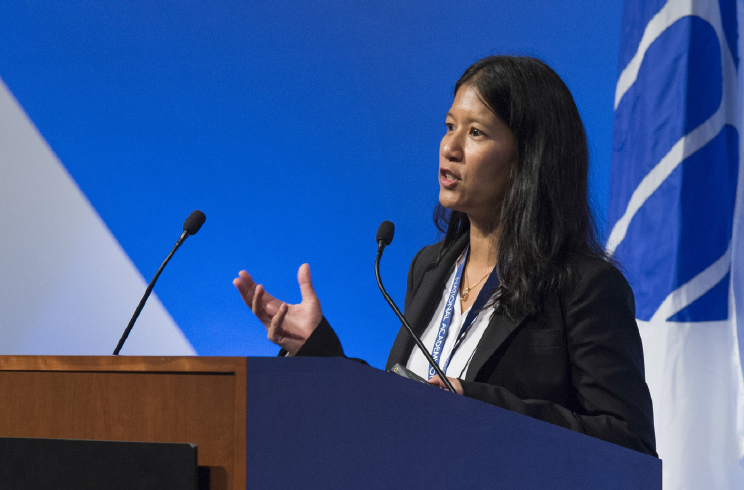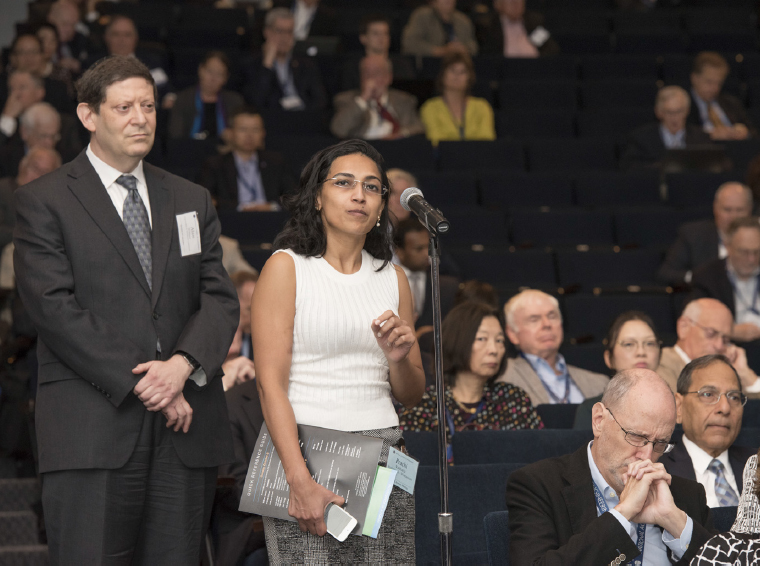1
Autonomy on Land and Sea and in the Air and Space
ON LAND
The forum of the 2017 annual meeting of the National Academy of Engineering opened with a video taken from the back seat of a car driving itself along local roads in Pittsburgh, accelerating onto the freeway, and pulling up at the passenger terminal of the Pittsburgh International Airport. As representative Bill Shuster, chair of the US House Transportation Committee, disembarked from the passenger seat of the car, he reported that the trip “was amazing.” He was so impressed that he asked the car’s manufacturer to bring it to Washington, where it drove members of Congress and other government officials around Capitol Hill and to the Pentagon, 6.5 miles away.
The technology that will make autonomous passenger vehicles possible is not only on the way, in many respects it is already here, said Raj Rajkumar, George Westinghouse Professor of Electrical and Computer Engineering at Carnegie Mellon University. And as the technology continues to advance and spread, its potential benefits are tremendous.
Every year about 1.3 million people around the world—including about 36,000 in the United States—die because of motor vehicle crashes and 94 percent of those crashes are due to human error, Rajkumar reported. Humans are uniquely conditioned to be distracted while driving, whether by smartphones, alcohol, anger, or simply looking at something. Computers, on the other hand, pay attention all the time. They are not distracted and therefore can react to situations that humans may not notice. For this reason the widespread adoption of autonomous vehicles could reduce motor vehicle fatalities by orders of magnitude, Rajkumar predicted, which would be “a big win for society.”
Benefits also can be measured in terms of productivity. People around the world spend enormous amounts of time waiting for stoplights to change, inching through heavy traffic, or otherwise stuck behind the wheel of their car. If vehicles could drive themselves, people could use that time more productively. “One could strongly argue that global economic productivity will quantifiably increase if vehicles can drive themselves,” Rajkumar said.
Furthermore, many older people eventually lose their driver’s license, which can severely reduce their quality of life. And in the United States alone, 1.5 million people who are blind and 5 million people with disabilities would have much greater mobility if they had access to autonomous vehicles. “This is truly a revolution in the making that will change the landscape of transportation as we know it,” said Rajkumar. “The only question is, when?”
The revolution faces many challenges. An unlimited number of unexpected things can happen on the road—a car may suddenly pull out, barriers can fall over in a construction zone, heavy rain or snow can impair vision, a road with a shoulder can suddenly become a bridge without a shoulder. People deal with these and other unexpected situations by using reason, common sense, and even social norms, such as ways of communicating with other drivers. Autonomous vehicles have to use hardware and software to navigate through unexpected circumstances, but the hardware and software in a car can be tested in only a limited number of conditions. “It’s going to be a while before we can make the assertion or guarantee that a vehicle will be safe in all conditions,” said Rajkumar.
Another challenge is that the components of an autonomous vehicle can fail, so redundancy must be built into the vehicle. This is a soluble problem from an engineering perspective, Rajkumar observed, but economic constraints are also a factor. At least initially, autonomous cars will be more costly than other vehicles, although eventually automation features will be manufactured in mass volumes and the “technology will be democratized.” But until then, only some people will be able to afford the benefits of autonomous vehicles.
GPS enables a vehicle to “know” exactly where it is on the planet, but Rajkumar pointed out that “there are lots of GPS-denied environments—under bridges, inside tunnels, in urban canyons, and such.”

Some companies are not relying on GPS and instead are working on the identification of landmarks to know where a vehicle is. But certain places have very few landmarks. “There are pros and cons to every approach you can take,” Rajkumar said. “My own philosophy is that you need to fuse together as many things as you can [to] get the best of all possible worlds.”
Cybersecurity poses additional challenges. “Imagine that a self-driving vehicle is basically taken over by a terrorist,” said Rajkumar. “There’s nobody to shoot at. . . . Now scale that to 100 or 1,000 vehicles all of a sudden going crazy, causing chaos throughout a city. Or imagine scaling that to an entire country, and then globally.”
Engineers have made progress on all these issues, Rajkumar noted, “but there is still a much longer way to go.” Counterintuitively, one barrier to the technology is the very high standards that autonomous vehicles must reach. Even the roughly 36,000 motor vehicle fatalities in the United States each year represent just one fatality for every 75 million miles driven, which is “a remarkably high bar for a technology. It’s going to take quite some time to get there.”
Beyond the technological challenges to autonomous vehicles are social and psychological challenges. “Will you as an individual be willing to give up control of the wheel when you and your family are in the car, especially driving at highway speeds, or navigating through an urban environment with a very dense conglomeration of pedestrians, bicyclists, motorcycles, and so on?” Rajkumar asked. “Will you feel comfortable for yourself, your family, and the rest of the people in the environment?” Furthermore, he added, when an accident happens, “the media will be all over it, and we don’t know what the social pushback will be.”
Autonomous vehicles are also likely to produce profound social dislocations. For example, most long-haul trucking is “a very logical candidate for automation.” From a technical standpoint, the technology is almost ready, although questions of training and regulation still need to be addressed. Similarly, if companies like Uber could remove drivers from cars, they could keep an additional 70 to 75 cents of every dollar received. “These are huge financial incentives,” said Rajkumar.
At some point, the transition to autonomous trucks, buses, taxis, and other vehicles will cause severe job loss, but Rajkumar anticipated that it will probably take years for these jobs to be eliminated entirely, which will allow time for planning and adjustment. He drew an analogy with agriculture. At the beginning of the 19th century a significant fraction of the US population worked on farms, and during the 20th century a substantial portion worked in factories. Most of those jobs no longer exist, yet the current unemployment rate is less than 5 percent. Rajkumar postulated that “Drivers whose jobs will be lost could earn even higher salaries working on sensors . . . and fixing equipment.”
Full autonomy for vehicles is not likely to be achieved in the near-term future, according to Rajkumar. Rather, improvements in autonomy are likely to be incremental.
The Society of Automotive Engineers has defined six levels of autonomy in vehicles (see box 1-1). Current lane departure warnings, traffic alerts, blind spot alerts, and other safety systems fall mostly in the lowest category of automation. As a point of reference, the autopilot in several cars sold today represents level 2 automation. Rajkumar predicted that “it’s going to take at least 10 years to get to level 5, but we’ll get to level 3 and level 4 in well-constrained, geographically
controlled environments.” For example, companies are working on the use of autonomous vehicles for transporting residents within gated communities where the vehicles stay on private roads. Of course, he acknowledged, this means that “only people who can afford to live in those gated communities can get those technologies in the near future.”
Currently, 100 million cars are sold each year around the world, representing a large and competitive market. Within the next two decades, the global vehicle automation market is expected to be $1.5–$2 trillion, said Rajkumar—not accounting for the impacts of unanticipated technological and social developments.
One intriguing question is whether autonomous vehicles might be overseen by a remote operator, so that the occupant of the vehicle does not need to pay attention to its operation. This would be a high-pressure job, observed Rajkumar, like that of an air traffic controller, and the labor costs would be high. Such jobs may eventually migrate to countries with lower labor costs, but then the laws of physics come into play, since a delay of several tens of milliseconds introduced by communicating with a distant operator could mean the difference between a vehicle stopping or driving off the road.
Another possibility is that public transportation could be transformed in unanticipated ways. For example, engineers have in the past proposed creating a system of rail-borne “pods” where people could get in a device and tell it where they want to go. This is basically what Uber and Lyft are trying to do, Rajkumar noted—taking the driver out of the picture.
The degree to which governments make the transportation infrastructure more intelligent will also be a factor. It is possible that they will not make such investments, in which case all the necessary sensors would need to be built into the vehicle to enable it to operate without special assistance. But if the infrastructure does become more intelligent, vehicles will be able to detect the color of a light, for example, when the sun is directly behind the light, when “humans have a hard time.” And if cars can signal to other vehicles when they are approaching an intersection, that will make the entire system more robust.
A fair amount of hyperbole currently surrounds the prospect of autonomous vehicles, Rajkumar concluded, but the revolution is “waiting to happen.” He predicted that autonomous vehicles will “transform society as we know it, reducing crashes, improving quality of life, and making our time in the car a lot more productive.”
AT SEA
Historically, people have explored the ocean from ships. But the ocean covers more than two-thirds of the planet, and ship-based exploration is expensive and sometimes dangerous. As a result, much of the ocean remains “unexplored, unmapped, and in a scientific sense poorly

understood,” said James Bellingham, director of the Center for Marine Robotics at the Woods Hole Oceanographic Institution.
The ocean is a strange place, Bellingham observed. It is big, deep, dark, and full of surprises. For example, cameras on underwater vehicles show that they are often surrounded by schools of fish, even in shark-infested waters where such behavior would seem to pose risks.
Beneath the surface, the ocean is a complex and changing environment characterized by currents, eddies, and vast quantities of life, much of which is poorly understood. For instance, creatures that live off the heat and chemical energy from hydrothermal vents were not discovered until the 1970s. “They are unaware that the sun even exists,” said Bellingham.
Today, robots are being used from above, on, and below the ocean surface to augment and supplement ships. New generations of robots can function for weeks underwater, cover thousands of miles, learn from unexpected situations, and operate from satellite signals rather than requiring a ship to accompany them. “We would like to be able to predict [the ocean] environment,” Bellingham explained, and “the best way we know how to do this is to use lots of robots.”
Oceanic robots have many applications. They are preparing, inspecting, repairing, operating, and decommissioning oil and gas equipment in the Gulf of Mexico and elsewhere. They are being used in aquaculture, wind power, telecommunications, mineral extraction, and many other industries associated with marine environments. Some of the greatest unsolved questions surrounding the climate system involve the ocean. For example, half the oxygen we breathe comes from phytoplankton, and a major scientific challenge is to figure out the role of these organisms in global ecosystems. “Some of the most exciting robotic experiments we’ve been running have revolved around attempting to understand the dynamics of this biological ocean,” said Bellingham.
The ocean is also a major source of terrestrial resources. “As the developing world increases its wealth, what’s the first thing people spend their money on? It’s protein—they want to eat meat,” Bellingham reported. “Meat produced in the terrestrial environment tends not to be environmentally friendly. And [humans are] doing a pretty good job of fishing down wild fisheries. So we think about aquaculture as a way of providing a food source for the growing population on our planet.” But doing so will require understanding this environment, getting a baseline of its condition, and making predictions about what will happen in the future and how policies or economic factors will affect that future.
The use of robots in the ocean can minimize the need for humans to be in risky environments. Bellingham illustrated with an analogy: “In many respects the ocean environment is not that dissimilar from space.” It is “very expensive to ensure [human] safety at a water depth of 6,000 meters or 10,000 pounds per square inch externally. You have to build a very large, complex platform supported by a fairly sophisticated surface vessel with a group of individuals who don’t do anything other than operate that platform.” By replacing people on oceanic platforms, robots can reduce costs, time, and risks. For example, searches for ships or airplanes lost at sea can proceed seven to ten times faster with robots than with ships towing search equipment behind them.
In hazardous areas, exploration could be done entirely by autonomous surface and underwater vehicles, with communication from the shore, as is the case with oil and gas exploration and production in the
Arctic. “As the Arctic opens up, there’s more and more human activity up there,” said Bellingham. “The first accidents will probably be ships running aground in waters that are very poorly charted. . . . The Coast Guard has to respond in a place where they have no response capability.” Robots could chart poorly known areas or provide situational awareness of accidents.
Surface vehicles are arguably the fastest growing component of marine robotics, Bellingham noted. “There’s been some fantastic innovation in that space, from very small vehicles that do things like scavenge energy from the wave field and use it to propel themselves very long distances [and] vehicles that use sails to go faster [and] autonomous cargo vessels.”
Robots designed to work underwater face a fundamental problem. Because the ocean contains salt, it is a conductor, which means that the radio waves used aboveground to control vehicles cannot be used underwater. Untethered vehicles in the ocean environment must therefore be autonomous. “As we like to say, think autonomy or die,” said Bellingham.
In addition, water is 1,000 times denser than the atmosphere, and drives the energy economics of motion. One consequence is that control loops can be closed more slowly.
But the underwater environment also poses enormous sensing problems. Cameras cannot see very far, sonar systems are expensive and power consuming, and navigation is complicated. Some devices have to surface to communicate with GPS; in other cases, human direction is unavailable, as when a robotic device explores under an ice sheet that extends all the way to the grounding line.
Reliability is essential and must be a central consideration in design, said Bellingham. “When I have a vehicle at sea and it has a problem, and we finally figure out what we did wrong, I want to incorporate that back into the design space, so that the next vehicle incorporates those lessons.” The design space includes the generation of computer code, he added, including automated code generation.
Another consideration is that multiple devices are typically active in a marine environment, each working—and in some cases learning—on its own. Work is now under way on creating communications links that
could provide a common situational awareness among platforms, so that they can, in effect, learn from each other.
“We’re living at the dawn of a new ocean century,” Bellingham concluded. “You’re going to see more and more of your food coming from the sea, and more and more of your energy coming from the sea. The winds are roughly twice as high over the ocean as they are over land, and with power increasing as velocity cubed that’s a big multiplier.” In addition, the sophisticated infrastructure in the ocean is going to require ongoing maintenance. “We’re going to move gradually out of the terrestrial environment and into the ocean environment, and robotics will allow it to happen.”
IN THE AIR
The airspace above the United States is regulated by the Federal Aviation Administration and divided into sectors, each monitored by an air traffic controller responsible for guiding aircraft so that they stay at least 5 nautical miles laterally and 1,000 feet vertically from other aircraft.
Claire Tomlin, Charles A. Desoer Chair at the College of Engineering, University of California, Berkeley, explained that air traffic controllers are in radio contact with all the aircraft in their sectors, but aircraft also have been highly automated for decades. Pilots essentially tell an aircraft what they want it to do, and the aircraft’s autopilot does what the pilot has directed. Over time, automation has become more sophisticated, with flight management systems that now interact with the autopilots and aircraft that communicate with each other.
However, a certified pilot is always involved, Tomlin said, in case anything unexpected arises. “We don’t know how to automate against all the things that could possibly happen,” she said. “We need a pilot there in the loop to take over if a situation comes up that hasn’t been grammed for.”
At the University of California, Berkeley, Tomlin and her colleagues have been thinking about how to introduce greater automation in the air traffic control system. A typical controller manages 12 to 15 aircraft that are grouped together by potential conflicts. The controllers spend much of their cognitive energy figuring out how to slow down, speed up, or

reroute aircraft so they maintain a safe distance. “Controllers are great at this,” she said. “They pride themselves on trying to resolve conflicts by ‘touching’ the minimum number of aircraft the minimum number of times.” Automating aspects of air traffic control requires automating this process, in part by adapting the current “rules of the road” and adhering to the idea of simplicity. At the same time, automation needs to keep humans in the loop, “which makes the automation design more challenging,” said Tomlin. Together, changes in the system make this “an exciting time in air traffic control.”
Air traffic control is about to become even more demanding as companies develop new technologies that use the air space. For example, unmanned aerial vehicles (UAVs) could add greatly to the demands on the air traffic control system but they are very useful in many circumstances. For example, they can gather information for search and rescue in a way that is much safer than sending first responders to the scene. Giving such systems more autonomy and functionality will reduce risks to people.
Another new technology is personal air mobility, or “flying cars,” that may enable people to move both on the ground and in the air in a single autonomous vehicle. “How do we think about the introduction of these vehicles, which are by design autonomous, so the person in the cockpit is just a regular person like you and is not necessarily a certified pilot?”
That said, the human in the loop does not need to be in the aircraft, Tomlin clarified. The pilot in charge of a personal aircraft could be on the ground keeping tabs on control of the aircraft, as is the case with military UAV flight. If the signals or on-board sensors of an aircraft were hacked, a human controller could serve as a fallback regardless of her location. “Ultimately, it’s the person who’s watching what all the aircraft are doing who starts to question whether an aircraft is going where it shouldn’t be going because somebody is hacking into the system.”
Tomlin said she has spent many hours sitting with air traffic controllers and watching what they do. “They spend their lifetime on a sector of air space, and they know that sector of air space like the back of their hand. They’ve seen all sorts of configurations of weather or disturbances, and they know how to deal with them. . . . That human component—they’ll do anything to save an aircraft—we don’t know how to automate that.”
The current air traffic control system is very safe, even though it relies on equipment that is relatively old. But the equipment has been certified, and air traffic controllers know how it works. Furthermore, older systems tend to be more secure, Tomlin said.
She is sometimes asked when planes will dispense with pilots completely. “When will we see FedEx jets taking off without pilots?” For the foreseeable future, she predicted that aircraft will have certified pilots on board. The big questions come up with personal air vehicles, which generally are being designed to fly without a [licensed] pilot. “That’s going to take a while.”
She pointed out that air traffic control would be a very different enterprise if 1,000 flying cars were in the air. “There’s a lot of other air space functionality that air traffic control provides as a service to people who fly that needs to be understood. How do you do this? How do you schedule things? How do you make it so that it all works together, including bigger jets? How do you avoid those little UAVs that are flying around? These are the big questions that have yet to be answered for flying cars.”

IN SPACE
Communication with a spacecraft on Mars takes from 4 to 21 minutes. Communication with one in orbit around Saturn takes 74 to 84 minutes. “With those kinds of one-way light times, continuous, ground-in-the-loop, closed-communication control and navigation of spacecraft simply is not possible,” said MiMi Aung, deputy division manager for autonomous systems at NASA’s Jet Propulsion Laboratory. So “the spacecraft have to operate autonomously on a normal basis.”
The landing of the Curiosity rover on Mars was a perfect example of the considerable demands made of autonomous vehicles in space. Carried by a rocket-powered delivery vehicle, the rover was lowered to the surface by a sky crane, after which the delivery vehicle flew away. The entire landing sequence, about 5 minutes long, “was totally autonomous,” said Aung, “from beginning to end.”
An even more sophisticated autonomous system is the technology that Aung and her colleagues are developing: the Mars helicopter. It could fly ahead of a rover or Mars astronauts and send back information to help them decide where to go. It also could go to places that humans
or rovers cannot, extending the reach of human explorers. “It’s a very exciting project.”
Designing such a helicopter requires solving many challenges. The density of the atmosphere on Mars is only about 1 percent that on Earth, which means that the lift provided by helicopter blades is extremely limited. Also, the nights are very cold, so the vehicle needs to emerge from the night with enough battery power to resume operations. One advantage of the Mars helicopter is that the force of gravity is only about four-fifths that of Earth, so it could carry more mass.
Aung and her colleagues have designed a helicopter with a 1.5-meter blade that is optimized for lift in a thin atmosphere. It spins up to about 2,800 revolutions per minute, which enables it to lift 1.8 kilograms of mass. Aung showed a video in which a prototype took off in a space simulator with an atmosphere like that of Mars. “This was a huge accomplishment that convinced everyone that it is possible to fly rotorcraft on Mars.”
The design constraints on an instrument package that weighs just 1.8 kg are daunting. To operate autonomously on Mars, the vehicle needs to be able to follow the waypoints of a trajectory specified ahead of time, probably from a base station elsewhere on the planet or in orbit around Mars. It needs a thermal control system that can survive the nighttime cold. It needs solar panels to collect energy, and very lightweight avionics and communication systems. Despite these demands, at the time of the forum Aung’s group was just a few months from testing a vehicle with these kinds of capabilities.
“This vehicle, at 1.8 kilograms and with this kind of capability, would not have been possible 15 years ago,” she noted. “The advancement of lightweight and capable avionics, sensors, and high-efficiency batteries and solar cells” were essential in the development of the technology.
The landing of the Curiosity rover was the first autonomous soft landing ever done of a large vehicle. The next step will be precision landing, with autonomous systems deciding where to land and then setting down with pinpoint accuracy.
Another milestone will be to go close to planetary bodies like comets and asteroids, pick up samples, and return them to Earth. “We are not short of ideas, we are not short of technology,” said Aung. But “the
opportunities to try these [technologies] out in space are few and far between, and they are expensive.”
The environments of space and other planets can never be reproduced perfectly on Earth. With the Mars helicopter, a flight chamber with thin air cannot simultaneously simulate the lower gravity and atmospheric dynamics involved. Although simulations, modeling, and partial tests can increase confidence that a technology will work, Aung explained that the final test is in the mission itself, which requires time and funding.
Technologies such as those used in the Mars helicopter also need to be reliable, she said. Spacecraft need to include fault detection, recording capacity, and recovery, since they typically are going to a place where humans have never been and interacting with an environment that is only partially understood.
The telecommunications industry has already demonstrated the tremendous benefits to be realized through the use of space, and new companies are emerging based on imaging from space. Possible future applications include mining in space, or manufacturing in space or on the moon materials that cannot be manufactured in Earth’s gravity. “Society is starting to use space as a socioeconomic platform,” Aung said.
DEALING WITH DATA
During the question-and-answer portion of the forum, the four panelists discussed several issues that apply to all autonomous vehicles, not just those in a particular domain. One issue concerns the amount of data generated by autonomous vehicles and how to process, store, and communicate those data in an efficient way.
Aung pointed to a fundamental question for all autonomous vehicles: How much of the data should be processed onboard and how much sent elsewhere for processing? With spacecraft, “there is a difference between data and information. Scientists tend to want every single bit of data collected from a planetary target. They’ve been waiting to get to it and they don’t trust processing algorithms that say, ‘Here is your information.’ That’s a continual conflict.” Computers and spacecraft

with better memory, processing speeds, and communication capabilities can help ease this conflict, she said.
With automobiles, storage media are getting cheaper, Rajkumar noted, and “in principle you could store a lot.” How much data can someone use and how much can be communicated? The answers to such questions lie along a spectrum, he said. Vehicles could store data online, communicate information to what he called “cloudlets” built into the transportation infrastructure, or send data directly to a more broad-based cloud. At the same time, “I expect that vehicles will have the same requirement as aviation—having a black box that records at least the past half hour and overwrites on top of that if there’s a crash.”
In the air, tactical avoidance of collisions has to be done using real-time data processed by the vehicles. But other things can be done on the ground, Tomlin explained, requiring that design and programming decisions reflect how and where data should be handled. Meanwhile, as data science, artificial intelligence, and control systems continue to improve, these decisions inevitably will change.
In the oceans, data are a major product of robotics, said Bellingham. “For our vehicles, the data they produce are the reason they exist.” For example, the data often serve as input for models, which themselves become sources of data. Some of the data from robots may come back to an operator in real time, which can allow an operator to decide what to do next, but “you often don’t get all the data on the platform until you get the platform back.”
RADICAL INNOVATIONS
Another broad topic of discussion concerned the many ways autonomous vehicles could transform aspects of the economy, society, and daily life. Rajkumar pointed out, for example, that cars are essentially steel cages to protect people from a crash. If autonomous vehicles are extremely safe (i.e., associated with fewer accidents than human-operated vehicles), the need for extensive protection will go away, so vehicles can become much lighter and therefore require less energy to move. Vehicles could even be configured as living rooms, dining rooms, offices, or bedrooms. The need for automobile insurance and car repair shops would decline dramatically. He speculated that if “nobody has a driver’s license and nobody knows how to drive, that future looks very interesting.”
Furthermore, technologies developed for vehicles could be applied to other sectors of the economy, he continued. Already, some of the early adopters of autonomous vehicles have been in the domains of agriculture, mining, and construction. With agriculture, access to GPS signals is uninterrupted, so machines can be programmed to seed, fertilize, harvest, and so on—companies “can automate the whole process.” Tomlin added that quad rotors are already available that can monitor crops and provide information about watering and fertilizing. And ground-to-air functionality can connect a quad rotor with robots on the ground and perform such functions as watering where the soil is dry. “There are great opportunities in agriculture where you can already buy a product.”
In mining and construction jobs robots could perform long and monotonous tasks. The costs of the sensors are relatively low compared with those of the equipment itself, making the cost of roboticization a

smaller constraint. “Those are very logical jobs to be automated,” said Rajkumar.
In the ocean, increasingly specialized robotic systems could become interdependent so that they support and build on each other. As more interdependent platforms in the ocean do important tasks for science, industry, and defense, “you get something that looks like a robot civilization,” said Bellingham. Economic systems will revolve around energy and information and be managed by oceanic platforms.
In air travel, people could go to an airport, say where they need to go, and the system would sell them a ticket on whatever airline would get them there. This would require a system, including an air traffic control system, that is “human-centric,” said Tomlin. It “allows the kind of economics and incentivization that we as humans are used to and allows us to put in our preferences and get a service that we’re happy with . . . in a safe and efficient way.”
Finally, space applications are not so much about replacing humans as about expanding human capability. “We have barely scratched the
surface of what we can do,” said Aung. Humans could live in orbit, on the moon, or on other planets, she said. In deep space, fleets of spacecraft could explore places where humans cannot go. “And we haven’t even talked about interstellar space. Is there some way to get there? How do we investigate?”
INSPIRING THE IMAGINATION OF YOUNG PEOPLE
Finally, the panelists touched on the many ways autonomous vehicles can inspire young people to innovate, investigate, and explore. Even at very early ages, Tomlin said, children can learn about science and engineering through robotics and automation. She is involved with a program called Girls in Engineering (supported by the National Science Foundation and private sector companies), in which participants build robots and their interest in engineering. “The conversation about inclusiveness has to start early.”
Bellingham noted that Earth is not the only planet with oceans. The moon Europa around Jupiter, Saturn’s moon Enceladus, and possibly even Pluto have subsurface oceans. Furthermore, orbiting around Jupiter or Saturn creates enough tidal stresses in moons that they probably have hydrothermal vents, which could heat liquids from below. Those moons “are probably our best chance to find life in the solar system,” he said. “And of course if we find life in the solar system in a second place, that means life is far more likely in our galaxy and in the universe than we think.” At the very least, he said, “these very different oceans have a lot to teach us about our oceans here on Earth.” It might not happen for a long time, but these oceans will be explored someday, “and it will be done by robots—very clever robots.”
The exploration of space has always fired the human imagination, said Aung. It can address such questions as whether we are alone and what is the structure of our solar system, our galaxy, and the universe. These are high-level questions in a world that is focused on the immediate and the practical. If children are introduced to these questions early in their educational experiences, and to the importance of acquiring fundamental knowledge in science, they will be starting out with the right mindset to answer the big questions facing humanity.



















